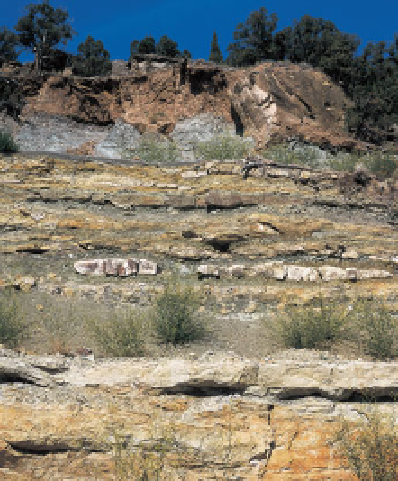Geoscience Reference
In-Depth Information
In many areas the Morrison is capped
and protected by the highly resistant
Cloverly Formation of the Lower
Cretaceous (
146
), and is underlain by the
Middle Jurassic Sundance Formation
representing the marine deposits of the
Sundance Sea. This succession, at both
Dinosaur National Monument and
Cleveland-Lloyd Dinosaur Quarry (Utah),
two of the most important Jurassic dinosaur
sites in the world, illustrates a regressional
sequence coincidental with the final
northward withdrawal of this vast, shallow
sea during the mid Jurassic. At the latter
location, for example, the intertidal beds of
the Summerville Formation (equivalent to
the Sundance) pass upwards into the
supratidal Tidwell Member, then into
fluvial and lacustrine deposits of the Salt
Wash Member, and finally into overbank
deposits with meandering rivers of the
Brushy Basin Member (Bilbey, 1998;
144
).
Over such a vast area there is clearly
enormous variation in the environment of
deposition of the Morrison Formation, but
in many of the richest beds the bone
accumulations were deposited in poorly
sorted sandstones that are thought to have
resulted from cataclysmic flash floods. The
wide, open plains left by the retreat of the
Sundance Sea and traversed by meandering
rivers, were home to herds of herbivorous
dinosaurs roaming the rivers and lakes in
search of vegetation. Cyclic periods of severe
drought, perhaps with a periodicity of 5, 10,
40, or 50 years as in Kenya today,
concentrated the dinosaur herds (and other
vertebrates) around remnant water holes
where they eventually died of dehydration
(as in the Chinle Group; Chapter 8).
Following such mass mortality, subsequent
flash floods swept the disarticulated bones a
short distance before burial in sandbodies
representing the channel fill of streams.
This situation was observed at the Dry
Mesa Dinosaur Quarry in Colorado by
Richmond and Morris (1998), where a
diverse assemblage, including 23 different
dinosaurs, plus pterosaurs, crocodiles,
turtles, mammals, amphibians, and lungfish
is preserved. The assemblage has gained
notoriety for its large sauropods, especially
Supersaurus
and
Ultrasaurus
.
Such mass death assemblages,
represented by bone-beds in the fossil
record, may be either catastrophic or
noncatastrophic accumulations. The
former is defined as sudden death (within a
few hours at most, e.g. a poisonous ash fall)
and includes all age and sexual groups.
Noncatastrophic mass mortality occurs over
a longer time span of hours up to months
(e.g. starvation). The killing agent can be
selective with regard to age, health,
gender, and social ranking of individuals
so that juveniles, females, and old adults
dominate numerically. Most of the
bone accumulations in the Morrison
Formation are considered to represent
noncatastrophic mass mortalities (Evanoff
and Carpenter, 1998) which are
characterized by a greater degree of
disarticulation due to the longer time span.
The preservation of the disarticulated
bones is favoured by an arid climate.
Dodson
et al
. (1980) suggested that
Morrison Formation dinosaur carcasses
146
146 The Lower Cretaceous Cloverly
Formation top overlays alternating
sandstones and shales of the Morrison
Formation bone beds; Wyoming Dinosaur
Center, Thermopolis, Wyoming.




Search WWH ::

Custom Search